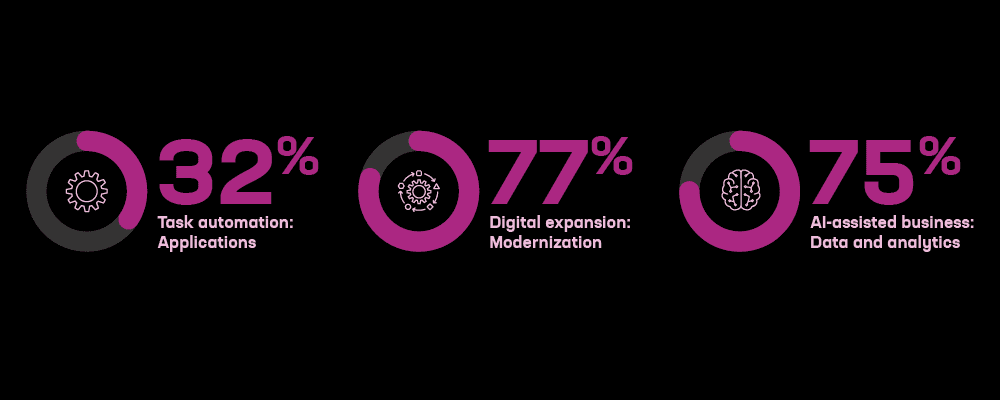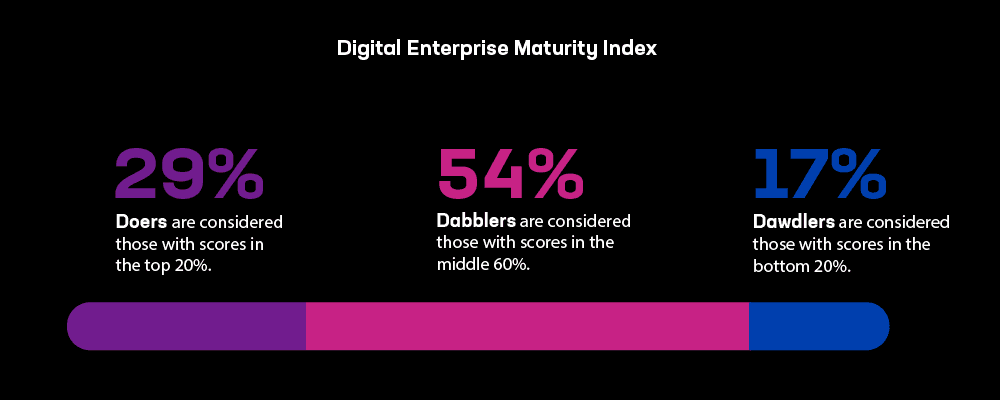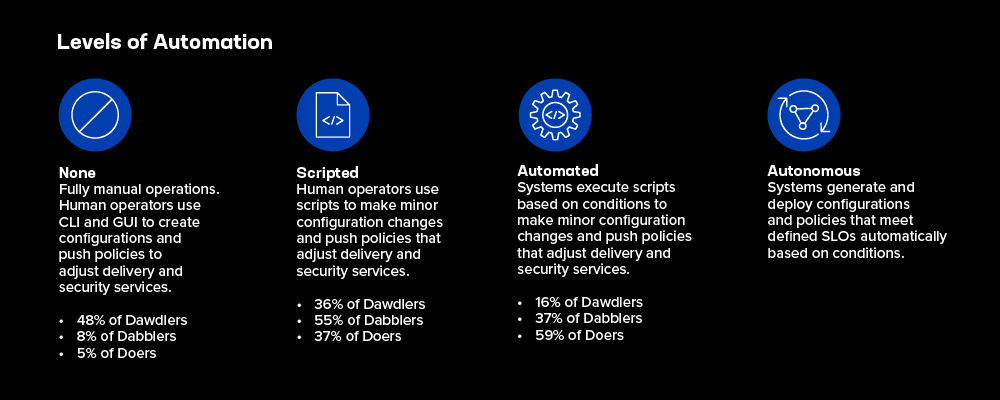Organizations are making great strides toward becoming digital businesses, but even the doers aren’t done yet. Digital transformation trends show great progress but the AI impact on business introduces new challenges to overcome.
We talk about digital transformation as though it’s a journey with a distinct destination. That implies an end at which point we can hold a celebratory party and pat ourselves on the back.
But unless technology is done evolving—and the past year or so proves that is simply not true—then the journey of digital transformation won’t ever be done, either.
That’s because the three phases represent cycles of transformation, always initiated by the introduction of new technology. Consider the three phases of digital transformation for a moment:

Source: F5 State of Application Strategy 2024
Applications This is the phase in which applications are being built to replace manual tasks. Just looking back to the beginning of the Internet Era, circa 2000, we can see that organizations have gone through this phase multiple times. Each generation of application architectures “restarts” this cycle, with organizations refactoring and rewriting and adding new applications to take advantage of new architectures and technology.
Modernization This is the phase in which IT doubles down on modernizing practices, tools, and technologies to operate, optimize, and secure all those new applications. This phase always follows the first, as new application architectures drive new needs and ways of working into operations that require reworking how we approach delivery and security. Consider how much cloud has changed operations. Now consider how much AI is going to change operations. See what I mean?
Data and Analytics Ah, the vaunted “final phase” of the cycle. Organizations figure out what data they need and how to analyze it to apply it to operations, workflows, and business functions to optimize them. This requires new practices and approaches, too. Consider that prior to 2020 most organizations viewed this phase as focusing on customer and corporate data. Today? It’s all about telemetry (operational data). And tomorrow, who knows?
Now, all this is to say that while we found that more organizations this year are doers, that is they are closing in on operating as a digital business, they aren’t done yet because, well, AI is here.

Source: F5 Digital Enterprise Maturity Index 2024
This is incredible progress, let’s not overlook that. Last year, in our first look at the digital maturity of enterprises, only 4% were in the doer category. Most were dabblers, at 65% of all organizations, and nearly twice as many were still dawdling in their journey. This year our research finds incredible progress toward digital business. Nearly three in ten (29%) are now doers and making great strides toward harnessing the power of AI.
But even under the mantle of digital doer remains a considerable amount of work, particularly on the operations side where AIOps is knocking at the door.
You see, even operations—IT—must go through these phases, and they often go through them at rates and times different than the business. In the case of operations, organizations are right back in the first phase, using applications to automate tasks and modernizing their practices and approaches, mostly by adopting SRE operations.

Source: F5 Digital Enterprise Maturity Index 2024
But as though to prove my point about digital transformation, the goalpost has been moved. With the arrival of generative AI, the ability to operate autonomously is no longer the purview of science fiction. Thus, though organizations—especially doers—have progressed quite well on the automation maturity scale, there is now a new destination on their organizational navigation system.
The AI impact on business is that to get there, organizations will have to restart the cycle with a new set of technologies, tools, approaches, and applications.
But I have no doubt they will get there, and their prior experiences and modernization efforts will increase the pace with which they progress though the cycle again. That’s the benefit of digital transformation, that organizations can quickly adopt, absorb, and harness the power of new technologies. That’s what it means to be a digital business.
To find out how organizations are performing in each phase—and what they need to do to progress—you can grab a copy of our second annual Digital Enterprise Maturity Index report.
About the Author

Related Blog Posts

Multicloud chaos ends at the Equinix Edge with F5 Distributed Cloud CE
Simplify multicloud security with Equinix and F5 Distributed Cloud CE. Centralize your perimeter, reduce costs, and enhance performance with edge-driven WAAP.
At the Intersection of Operational Data and Generative AI
Help your organization understand the impact of generative AI (GenAI) on its operational data practices, and learn how to better align GenAI technology adoption timelines with existing budgets, practices, and cultures.
Using AI for IT Automation Security
Learn how artificial intelligence and machine learning aid in mitigating cybersecurity threats to your IT automation processes.
Most Exciting Tech Trend in 2022: IT/OT Convergence
The line between operation and digital systems continues to blur as homes and businesses increase their reliance on connected devices, accelerating the convergence of IT and OT. While this trend of integration brings excitement, it also presents its own challenges and concerns to be considered.
Adaptive Applications are Data-Driven
There's a big difference between knowing something's wrong and knowing what to do about it. Only after monitoring the right elements can we discern the health of a user experience, deriving from the analysis of those measurements the relationships and patterns that can be inferred. Ultimately, the automation that will give rise to truly adaptive applications is based on measurements and our understanding of them.
Inserting App Services into Shifting App Architectures
Application architectures have evolved several times since the early days of computing, and it is no longer optimal to rely solely on a single, known data path to insert application services. Furthermore, because many of the emerging data paths are not as suitable for a proxy-based platform, we must look to the other potential points of insertion possible to scale and secure modern applications.
